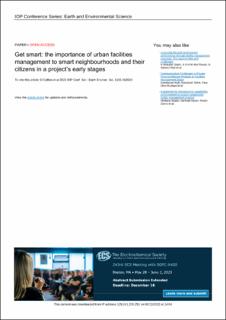| dc.contributor.author | Collins, Dave | |
| dc.contributor.author | Johansen, Agnar | |
| dc.contributor.author | Temeljotov Salaj, Alenka | |
| dc.contributor.author | Senior, Coline | |
| dc.date.accessioned | 2023-01-05T15:09:20Z | |
| dc.date.available | 2023-01-05T15:09:20Z | |
| dc.date.created | 2022-12-08T15:15:14Z | |
| dc.date.issued | 2022 | |
| dc.identifier.issn | 1755-1307 | |
| dc.identifier.uri | https://hdl.handle.net/11250/3041373 | |
| dc.description.abstract | The purpose of this paper is to demonstrate how citizen participation as part of Urban Facility Management both as a consideration and practical application can contribute to the positive development of human-centred Smart Neighbourhoods. Through a combination of desk research and data from an ongoing research project in Norway, this paper will use literature to provide a theoretical link between these concepts whilst also showing how this link can be demonstrated in real work projects in the Norwegian Municipality of Lier. The findings illustrate that Facilities Management-focused urban planning processes allow for citizenoptimized communities, well planned and easy-to-implement maintenance strategies that ensure the long-term viability of Smart and Sustainable Cities. The results of this paper can be important for the development of Urban FM as a field, the reorientation of FM as not just a building level concept, but community level and has applicability to the fields of FM, architecture, urban planning, and Smart Cities. | en_US |
| dc.description.abstract | Get smart: the importance of urban facilities management to smart neighbourhoods and their citizens in a project’s early stages | en_US |
| dc.description.abstract | The purpose of this paper is to demonstrate how citizen participation as part of Urban Facility Management both as a consideration and practical application can contribute to the positive development of human-centred Smart Neighbourhoods. Through a combination of desk research and data from an ongoing research project in Norway, this paper will use literature to provide a theoretical link between these concepts whilst also showing how this link can be demonstrated in real work projects in the Norwegian Municipality of Lier. The findings illustrate that Facilities Management-focused urban planning processes allow for citizen-optimized communities, well planned and easy-to-implement maintenance strategies that ensure the long-term viability of Smart and Sustainable Cities. The results of this paper can be important for the development of Urban FM as a field, the reorientation of FM as not just a building level concept, but community level and has applicability to the fields of FM, architecture, urban planning, and Smart Cities. | en_US |
| dc.language.iso | eng | en_US |
| dc.publisher | IOP Publishing | en_US |
| dc.rights | Navngivelse 4.0 Internasjonal | * |
| dc.rights.uri | http://creativecommons.org/licenses/by/4.0/deed.no | * |
| dc.title | Get smart: the importance of urban facilities management to smart neighbourhoods and their citizens in a project’s early stages | en_US |
| dc.title.alternative | Get smart: the importance of urban facilities management to smart neighbourhoods and their citizens in a project’s early stages | en_US |
| dc.type | Peer reviewed | en_US |
| dc.type | Journal article | en_US |
| dc.description.version | publishedVersion | en_US |
| dc.source.volume | 1101 | en_US |
| dc.source.journal | IOP Conference Series: Earth and Environmental Science (EES) | en_US |
| dc.identifier.doi | 10.1088/1755-1315/1101/6/062020 | |
| dc.identifier.cristin | 2090773 | |
| cristin.ispublished | true | |
| cristin.fulltext | original | |
| cristin.qualitycode | 1 | |

